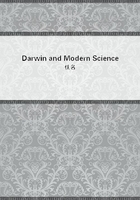
第303章
The coincidence between the spectroscopic and the photometric evidence permits us to feel complete confidence in the theory of eclipses. When then we find a star with a light-curve of perfect regularity and with a characteristics of that of Algol, we are justified in extending the theory of eclipses to it, although it may be too faint to permit of adequate spectroscopic examination. This extension of the theory secures a considerable multiplication of the examples available for observation, and some 30 have already been discovered.
Dr Alexander Roberts, of Lovedale in Cape Colony, truly remarks that the study of Algol variables "brings us to the very threshold of the question of stellar evolution." ("Proc. Roy. Soc. Edinburgh", XXIV. Part II.
(1902), page 73.) It is on this account that I propose to explain in some detail the conclusion to which he and some other observers have been led.
Although these variable stars are mere points of light, it has been proved by means of the spectroscope that the law of gravitation holds good in the remotest regions of stellar space, and further it seems now to have become possible even to examine the shapes of stars by indirect methods, and thus to begin the study of their evolution. The chain of reasoning which Ishall explain must of necessity be open to criticism, yet the explanation of the facts by the theory is so perfect that it is not easy to resist the conviction that we are travelling along the path of truth.
The brightness of a star is specified by what is called its "magnitude."The average brightness of all the stars which can just be seen with the naked eye defines the sixth magnitude. A star which only gives two-fifths as much light is said to be of the seventh magnitude; while one which gives 2 1/2 times as much light is of the fifth magnitude, and successive multiplications or divisions by 2 1/2 define the lower or higher magnitudes. Negative magnitudes have clearly to be contemplated; thus Sirius is of magnitude minus 1.4, and the sun is of magnitude minus 26.
The definition of magnitude is also extended to fractions; for example, the lights given by two candles which are placed at 100 feet and 100 feet 6inches from the observer differ in brightness by one-hundredth of a magnitude.
A great deal of thought has been devoted to the measurement of the brightness of stars, but I will only describe one of the methods used, that of the great astronomer Argelander. In the neighbourhood of the star under observation some half dozen standard stars are selected of known invariable magnitudes, some being brighter and some fainter than the star to be measured; so that these stars afford a visible scale of brightness.
Suppose we number them in order of increasing brightness from 1 to 6; then the observer estimates that on a given night his star falls between stars 2and 3, on the next night, say between 3 and 4, and then again perhaps it may return to between 2 and 3, and so forth. With practice he learns to evaluate the brightness down to small fractions of a magnitude, even a hundredth part of a magnitude is not quite negligible.
For example, in observing the star RR Centauri five stars were in general used for comparison by Dr Roberts, and in course of three months he secured thereby 300 complete observations. When the period of the cycle had been ascertained exactly, these 300 values were reduced to mean values which appertained to certain mean places in the cycle, and a mean light-curve was obtained in this way. Figures titled "Light curve of RR Centauri" (Fig. 5)and "The light-curve and system of Beta Lyrae" (Fig. 7) show examples of light curves.
I shall now follow out the results of the observation of RR Centauri not only because it affords the easiest way of explaining these investigations, but also because it is one of the stars which furnishes the most striking results in connection with the object of this essay. (See "Monthly notices R.A.S." Vol. 63, 1903, page 527.) This star has a mean magnitude of about 7 1/2, and it is therefore invisible to the naked eye. Its period of variability is 14h 32m 10s.76, the last refinement of precision being of course only attained in the final stages of reduction. Twenty-nine mean values of the magnitude were determined, and they were nearly equally spaced over the whole cycle of changes. The black dots in Fig. 5 exhibit the mean values determined by Dr Roberts. The last three dots on the extreme right are merely the same as the first three on the extreme left, and are repeated to show how the next cycle would begin. The smooth dotted curve will be explained hereafter, but, by reference to the scale of magnitudes on the margins of the figure, it may be used to note that the dots might be brought into a perfectly smooth curve by shifting some few of the dots by about a hundredth of a magnitude.
This light-curve presents those characteristics which are due to successive eclipses, but the exact form of the curve must depend on the nature of the two mutually eclipsing stars. If we are to interpret the curve with all possible completeness, it is necessary to make certain assumptions as to the stars. It is assumed then that the stars are equally bright all over their disks, and secondly that they are not surrounded by an extensive absorptive atmosphere. This last appears to me to be the most dangerous assumption involved in the whole theory.